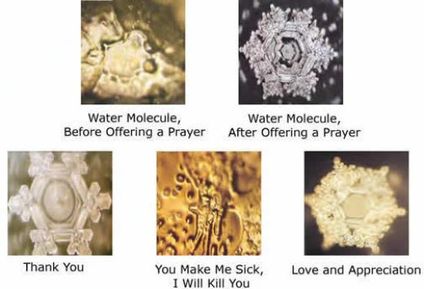Can thoughts really change water’s structure?
“It was 1994 when the idea to freeze water and observe it with microscope came upon me. With this method, I was convinced that I should be able to see something like snow crystals,” says Masaru Emoto, the now (in)famous scientist behind the four-volume book Messages from Water, which went on to be featured in the controversial documentary What the Bleep Do We Know?. Emoto’s work is considered seminal by alternative and holistic medicine communities while being “disproven” by traditional science.
“At first, we strenuously observed crystals of tap water, river water, and lake water. From the tap water we could not get any beautiful crystals. We could not get any beautiful ones from rivers and lakes near big cities, either. However, from the water from rivers and lakes where water is kept pristine from development, we could observe beautiful crystals with each one having its own uniqueness.”
Emoto and his team froze water and photographed it. They then ran experiments on distilled, or “pure”, water, analyzing the impact of music, prayer, thought—in short, intention—on water molecules. Their photos reveal remarkable differences in positive and negative intention on the water molecules’ ability to form crystals.
“The result was that we always observed beautiful crystals after giving good words, playing good music, and showing, playing, or offering pure prayer to water. On the other hand, we observed disfigured crystals in the opposite situation. Moreover, we never observed identical crystals.”
Attempts to recreate the experiment in double- and triple-blind studies have not yielded the same results, which is why many traditionalists call the research biased at best and a hoax at worst. But given that intention is the variable, how can anyone isolate their feelings from the experiment?
While he presented the findings to the world as research, it appears Emoto may have been well aware that his failure to follow strictly the scientific method would discredit his experiments. He says, “This world is filled with wonders and mysteries that get more incomprehensible if we try to think of a reason.”
Though he attempted to use reason—that is, science—to prove his point, its shortcoming is that fact. The mere belief that intention can change molecular structure is the proof. As humans, made up of somewhere around half water ourselves, we want to believe positive thought and intention can change our crystalline structure too.
“The photograph of crystals is neither science nor religion. I hope it is enjoyed as a new type of art. Nevertheless, the world it shows is truth, and there is no doubt that many messages essential to our lives are hidden in it.”
Image: Your Sole Sister

